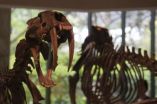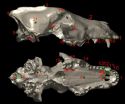(Press-News.org) LOS ANGELES — Concerns about climate change and its impact on the world around us are growing daily. New scientific studies at the La Brea Tar Pits are probing the link between climate warming and the evolution of Ice Age predators, attempting to predict how animals will respond to climate change today.
The La Brea Tar Pits are famous for the amazing array of Ice Age fossils found there, such as ground sloths, mammoths, and predators like saber-toothed cats and powerful dire wolves. But the climate during the end of the Ice Age (50,000-11,000 years ago) was unstable, with rapid warming and cooling. New research reported here has documented the impact of this climate change on La Brea predators for the first time.
Two new studies published by research associates at of the Page Museum document significant change over time in the skulls of both dire wolves and saber-toothed cats. "Different tar pits at La Brea accumulated at different times," said F. Robin O'Keefe of Marshall University, lead author on the dire wolf study (Palaeontologia Electronica, April 9, 2014). "When we compare fossils deposited at different times, we see big changes. We can actually watch evolution happening."
After the end of the last Ice Age, La Brea dire wolves became smaller and more graceful, adapting to take smaller prey as glaciers receded and climate warmed. This rapidly changing climate drove change in saber-toothed cats as well. "Saber-toothed cats show a clear correlation between climate and shape. Cats living after the end of the Ice Age are larger, and adapted to taking larger prey," said Julie Meachen of Des Moines University, lead author on the sabertooth study (Journal of Evolutionary Biology, 2014).
The two scientists discuss their work in a video here: http://www.youtube.com/watch?v=jK_DKSNbgR4&feature=youtu.be
"We can see animals adapting to a warming climate at La Brea," said O'Keefe. "Then humans show up and all the big ones disappear. We haven't been able to establish causality there yet. But we are working on it."
The emerging links between climate change and evolution needs further study. There are many unanswered questions; such as why predators change in the ways that they do, the importance of factors other than climate, and whether the arrival of humans played a role in the mass extinction at the end of the Ice Age. "There is much work to be done on the specimens from the tar pits. We are working actively to bring together the researchers and resources needed to expand on these discoveries," says John Harris, chief curator at the Page Museum. "Climate change is a pressing issue for all of us, and we must take advantage of what Rancho La Brea can teach us about how ecosystems react to it."
INFORMATION:
O'Keefe, F. R., W. J. Binder, S. R. Frost, R. W. Sadleir, and B. Van Valkenburgh. 2014. Cranial morphometrics of the dire wolf, Canis dirus, at Rancho La Brea: temporal variability and its links to nutrient stress and climate. Palaeontologia Electronica.
Palaeontologia Electronica was the first peer-reviewed online paleontology journal in the world and has been in publication for 17 years. On April 9, visit palaeo-electronica.org/content/2014/723-canis-dirus-craniometrics
Meachen, J. A., F. R. O'Keefe, and R. W. Sadleir. 2014. Evolution in the sabre-tooth cat, Smilodon fatalis, in response to Pleistocene climate change. Journal of Evolutionary Biology 27: 714-723.
Visit http://onlinelibrary.wiley.com/doi/10.1111/jeb.12340/abstract
About the Natural History Family of Museums
The Natural History Family of Museums includes the NHM, the Page Museum at the La Brea Tar Pits (Hancock Park/Mid-Wilshire), and the William S. Hart Park and Museum (Newhall, California). The Family of Museums serves more than one million families and visitors annually, and is a national leader in research, exhibitions and education.
About the Page Museum at the La Brea Tar Pits
The Page Museum at the La Brea Tar Pits is located at one of the world's most famous fossil localities. The Museum displays Ice Age fossils — including saber-toothed cats, dire wolves, and mammoths, and also holds one of the richest and most well-preserved fossil insect collections from 10,000 to 60,000 year-old asphalt deposits. For more information, call (323) 857-6300 or visit http://www.tarpits.org.
La Brea Tar Pit fossil research shows climate change drove evolution of Ice Age predators
2014-04-10
ELSE PRESS RELEASES FROM THIS DATE:
Acupuncture normalizes brain structure and damaged neurons following heroin relapse
2014-04-10
Heroin abuse can damage many brain areas, including the pedunculopontine tegmental nucleus of the midbrain, the ventral tegmental area, and nucleus accumbens. Persistent use of heroin induced irreversible damage to the nervous system. To verify the relationship between acupuncture, neurotrophic factor expression and brain cell structural changes, a research team from Anhui University of Chinese Medicine in China established a rat model of heroin relapse using intramuscular injection of increasing amounts of heroin. During the detoxification period, rat models received acupuncture ...
Brainy courage of the rainbowfish
2014-04-10
The boldest black-lined rainbowfish are those that are born in the wild. Also more fearless are those that analyze information both sides of their brains. This is the conclusion of Australian researchers Culum Brown and Anne-Laurence Bibost from Macquarie University, in a study published in Springer's journal Behavioral Ecology and Sociobiology.
The preference to analyze and react to information with either the left or right hemisphere of the brain is called cerebral lateralization, and is widespread among vertebrates. Lateralization is seen in the preference of humans ...
Identified epigenetic factors associated with an increased risk of developing cancer
2014-04-10
In 10% of human tumors there is a family history of hereditary disease associated with mutations in identified genes. The best examples are the cases of polyps in the large intestine associated with the APC gene and breast cancer associated with BRCA1 and BRCA2 genes. In the remaining 90% of cases are believed to have an increased risk of developing cancer in relation to genetic variants less powerful but more often, for example, doubles the risk of having a tumor that lacks this small change, called polymorphism.
In the last decade, hundreds of studies have been conducted ...
Experts disagree on horses with incoordination
2014-04-10
A trip to the veterinarian may prove fatal to a horse, even if it is not necessary to put the animal down. In Europe if the horse is found to be ataxic, which is most often due to the disease 'wobbler syndrome', the horse is likely to be put down immediately. If a horse suffers from this disease, putting it down can be a necessity, as the animal can be dangerous to ride and handle. But now new research from the University of Copenhagen and the Royal Veterinary College in the UK shows marked disagreement among experts about when a horse is ataxic and severity of the ataxia. ...
Proof that antidepressants and breastfeeding can mix
2014-04-10
University of Adelaide researchers have found that women on antidepressant medication are more successful at breastfeeding their babies if they keep taking the medication, compared with women who quit antidepressants because of concerns about their babies' health.
These results have been presented this week at the 18th Perinatal Society of Australia and New Zealand (PSANZ) Annual Conference in Perth.
Using data from the Danish National Birth Cohort in Denmark, researchers in the University of Adelaide's Robinson Research Institute studied the outcomes of 368 women who ...
Special function of nestin+ neurons in medial septum-diagonal band of Broca in adult rats
2014-04-10
Dr. Yuhong Zhao and co-workers from Sun Yat-sen University in China explored the projection of nestin+ neurons to the olfactory bulb and the time course of nestin+ neurons in the medial septum-diagonal band of Broca in adult rats during injury recovery after olfactory nerve transection. These researchers observed that all nestin+ neurons were double-labeled with ChAT in the medial septum-diagonal band of Broca. Approximately 53.6% of nestin+ neurons were projected to the olfactory bulb and co-labeled with fast blue. A large number of nestin+ neurons were not present in ...
Increased time on Facebook could lead women to negative body images
2014-04-10
Washington, DC (April 7, 2014) – The mediated version of what women should look like has always been under scrutiny, particularly looking at actresses and fashion models. But what about body image from social networks and friends? A recent study by researchers in the United Kingdom and United States, found that more time on Facebook could lead to more negative feelings and more comparisons to the bodies of friends.
Petya Eckler, University of Strathclyde; Yusuf Kalyango Jr., Ohio University; and Ellen Paasch, University of Iowa will present their findings at the 64th ...
Co-signor for ex-spouse's student loans discharged in bankruptcy
2014-04-10
Co-signor for ex-spouse's student loans discharged in bankruptcy
Article provided by Claeys, McElroy-Magruder & Kitchens
Visit us at http://www.letangiehelp.com
In the case of In re Zumbro, the U.S. Eleventh Circuit Court of Appeals ruled that the district court was correct in upholding the bankruptcy court's order decision determining that student loans co-signed by the debtor were dischargeable in bankruptcy under a hardship exception.
The"Brunner"test
Bankruptcy courts apply a three-prong Brunner test for ordering a discharge of student loan debt. The ...
Veterans: Honorable service, but an endless wait for disability benefits
2014-04-10
Veterans: Honorable service, but an endless wait for disability benefits
Article provided by Manring & Farrell
Visit us at http://www.manringfarrell-socialsecuritylaw.com
Backlog and delay
While serving in Vietnam, a soldier was exposed for several minutes to Agent Orange, raining down, in his words, "like they were giving us a shower." Now 64, he has waited approximately four years for his claim for disability benefits to be resolved by the Veterans Benefits Administration, one pending case among 2.1 million. Across the nation, according to the Dayton Daily ...
High-profile accident raises awareness of dangers faced by pedestrians
2014-04-10
High-profile accident raises awareness of dangers faced by pedestrians
Article provided by Callahan & Blaine
Visit us at http://www.personalinjury-arizona.com
The recent high-profile accident at the South-by-Southwest (SXSW) music festival in Austin, Texas, has put the spotlight on the hazards faced by pedestrians all over the country. In the tragic SXSW incident, a drunk driver being chased by police drove through a street barricade directly into a crowd of people, killing three and injuring nearly two dozen more. The driver has been charged with capital murder ...



